Abstract
The relationship between acquired cellular resistance and delayed-type hypersensitivity (DTH) during the immune response to Listeria monocytogenes was investigated. Treatment of concanavalin A-stimulated Listeria-immune spleen cells with anti-CD8 antibody plus complement abrogated the adoptive transfer of systemic antilisterial immunity but had no effect on the transfer of DTH. In contrast, in vitro depletion of the CD4+ T-cell subset eliminated the ability of culture-activated cells to transfer DTH reactivity but did not interfere with the adoptive transfer of protection. In vivo, the infusion of anti-CD8 antibody inhibited the expression of both actively and adoptively transferred protection but did not influence the development of DTH skin test reactivity to L. monocytogenes antigens. In vivo depletion of the CD4+ T-cell subset eradicated the DTH response, with only minor influence of the protective anti-Listeria response. The apparent functional dissociation of the CD4+ (DTH) and CD8+ (protection) T-cell populations was further emphasized by our findings that the adoptive transfer of protection was dependent on a cyclophosphamide-sensitive cell population, whereas DTH reactivity was mediated by a cyclophosphamide-resistant population.
Full text
PDF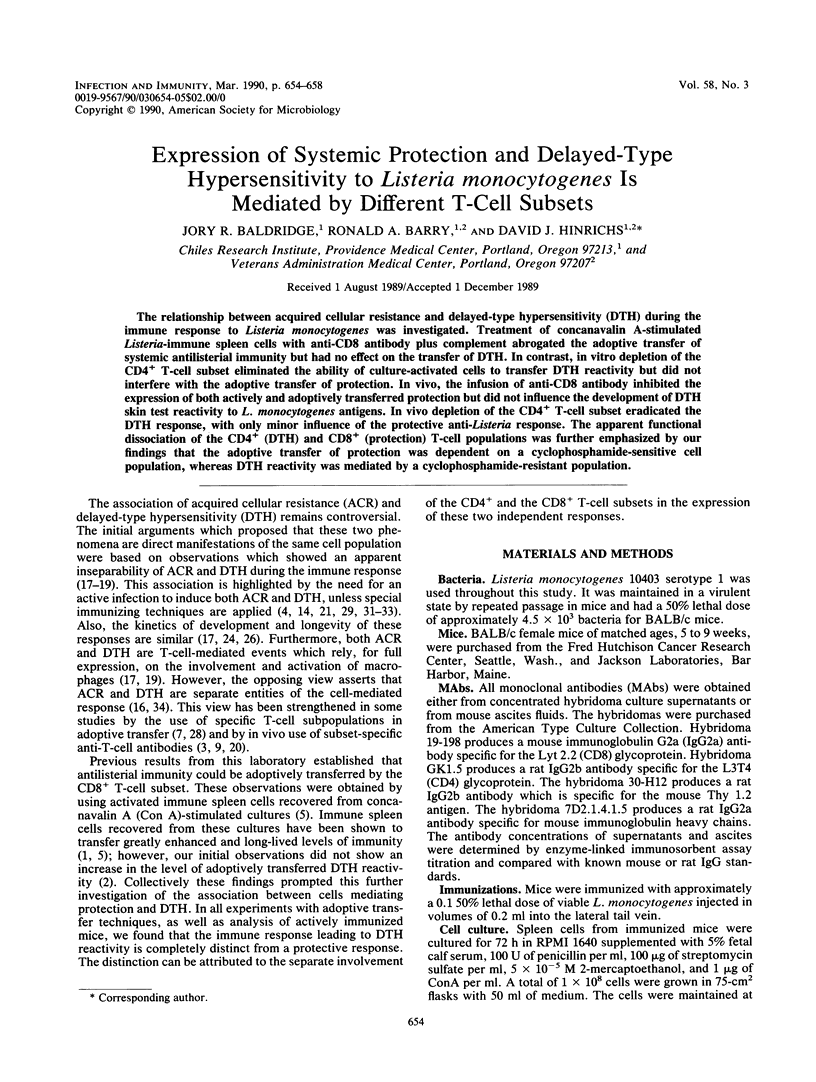
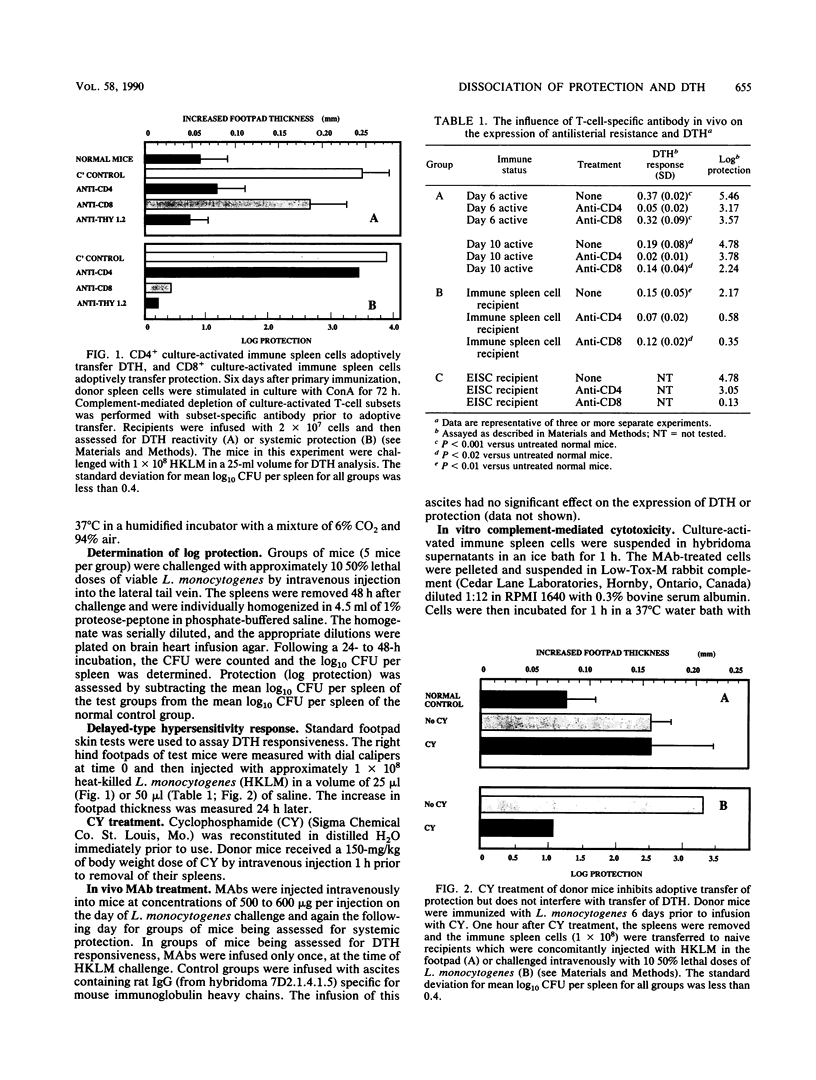
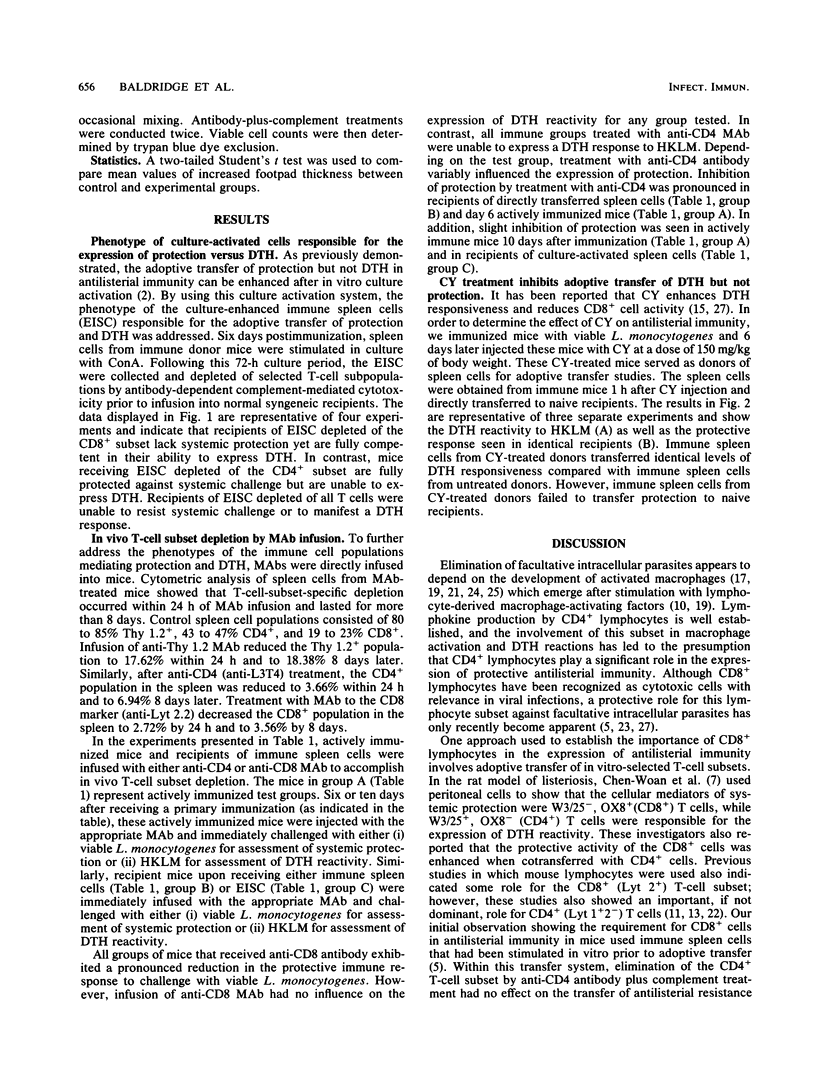
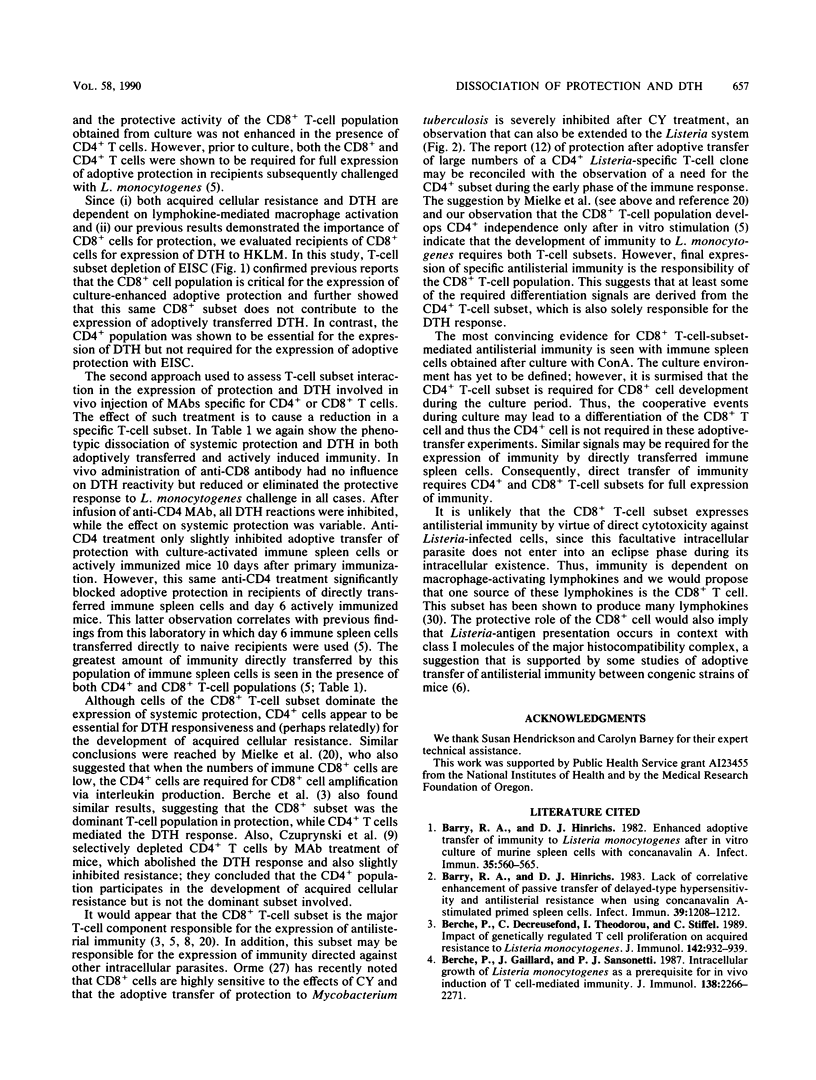
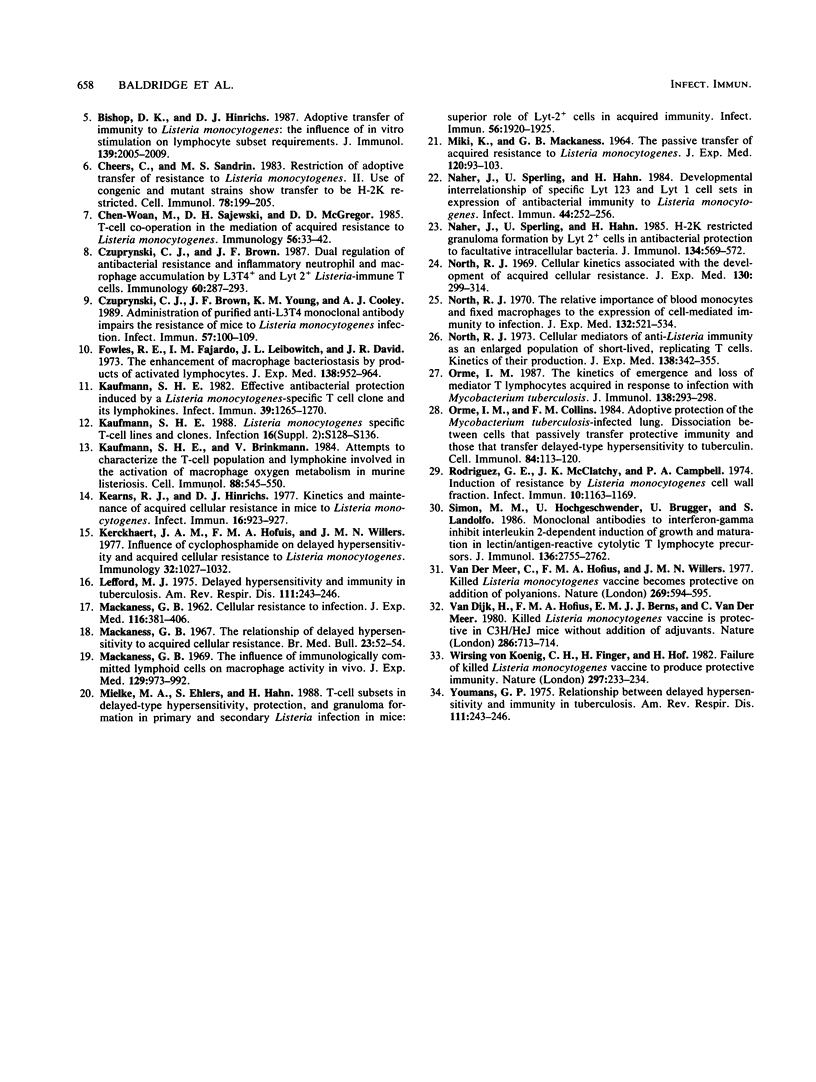
Selected References
These references are in PubMed. This may not be the complete list of references from this article.
- Barry R. A., Hinrichs D. J. Enhanced adoptive transfer of immunity to Listeria monocytogenes after in vitro culture of murine spleen cells with concanavalin A. Infect Immun. 1982 Feb;35(2):560–565. doi: 10.1128/iai.35.2.560-565.1982. [DOI] [PMC free article] [PubMed] [Google Scholar]
- Barry R. A., Hinrichs D. J. Lack of correlative enhancement of passive transfer of delayed-type hypersensitivity and antilisterial resistance when using concanavalin A-stimulated primed spleen cells. Infect Immun. 1983 Mar;39(3):1208–1213. doi: 10.1128/iai.39.3.1208-1213.1983. [DOI] [PMC free article] [PubMed] [Google Scholar]
- Berche P., Decreusefond C., Theodorou I., Stiffel C. Impact of genetically regulated T cell proliferation on acquired resistance to Listeria monocytogenes. J Immunol. 1989 Feb 1;142(3):932–939. [PubMed] [Google Scholar]
- Berche P., Gaillard J. L., Sansonetti P. J. Intracellular growth of Listeria monocytogenes as a prerequisite for in vivo induction of T cell-mediated immunity. J Immunol. 1987 Apr 1;138(7):2266–2271. [PubMed] [Google Scholar]
- Bishop D. K., Hinrichs D. J. Adoptive transfer of immunity to Listeria monocytogenes. The influence of in vitro stimulation on lymphocyte subset requirements. J Immunol. 1987 Sep 15;139(6):2005–2009. [PubMed] [Google Scholar]
- Cheers C., Sandrin M. S. Restriction in adoptive transfer of resistance to Listeria monocytogenes. II. Use of congenic and mutant mice show transfer to be H-2K restricted. Cell Immunol. 1983 Jun;78(2):199–205. doi: 10.1016/0008-8749(83)90274-5. [DOI] [PubMed] [Google Scholar]
- Chen-Woan M., Sajewski D. H., McGregor D. D. T-cell co-operation in the mediation of acquired resistance to Listeria monocytogenes. Immunology. 1985 Sep;56(1):33–42. [PMC free article] [PubMed] [Google Scholar]
- Czuprynski C. J., Brown J. F. Dual regulation of anti-bacterial resistance and inflammatory neutrophil and macrophage accumulation by L3T4+ and Lyt 2+ Listeria-immune T cells. Immunology. 1987 Feb;60(2):287–293. [PMC free article] [PubMed] [Google Scholar]
- Czuprynski C. J., Brown J. F., Young K. M., Cooley A. J. Administration of purified anti-L3T4 monoclonal antibody impairs the resistance of mice to Listeria monocytogenes infection. Infect Immun. 1989 Jan;57(1):100–109. doi: 10.1128/iai.57.1.100-109.1989. [DOI] [PMC free article] [PubMed] [Google Scholar]
- Fowles R. E., Fajardo I. M., Leibowitch J. L., David J. R. The enhancement of macrophage bacteriostasis by products of activated lymphocytes. J Exp Med. 1973 Oct 1;138(4):952–964. doi: 10.1084/jem.138.4.952. [DOI] [PMC free article] [PubMed] [Google Scholar]
- Kaufmann S. H., Brinkmann V. Attempts to characterize the T-cell population and lymphokine involved in the activation of macrophage oxygen metabolism in murine listeriosis. Cell Immunol. 1984 Oct 15;88(2):545–550. doi: 10.1016/0008-8749(84)90186-2. [DOI] [PubMed] [Google Scholar]
- Kaufmann S. H. Effective antibacterial protection induced by a Listeria monocytogenes-specific T cell clone and its lymphokines. Infect Immun. 1983 Mar;39(3):1265–1270. doi: 10.1128/iai.39.3.1265-1270.1983. [DOI] [PMC free article] [PubMed] [Google Scholar]
- Kaufmann S. H. Listeria monocytogenes specific T-cell lines and clones. Infection. 1988;16 (Suppl 2):S128–S136. doi: 10.1007/BF01639735. [DOI] [PubMed] [Google Scholar]
- Kearns R. J., Hinrichs D. J. Kinetics and maintenance of acquired resistance in mice to Listeria monocytogenes. Infect Immun. 1977 Jun;16(3):923–927. doi: 10.1128/iai.16.3.923-927.1977. [DOI] [PMC free article] [PubMed] [Google Scholar]
- Kerckhaert J. A., Hofhuis F. M., Willers J. M. Influence of cyclophosphamide on delayed hypersensitivity and acquired cellular resistance to Listeria monocytogenes in the mouse. Immunology. 1977 Jun;32(6):1027–1032. [PMC free article] [PubMed] [Google Scholar]
- Lefford M. J. Editorial: Delayed hypersensitivity and immunity in tuberculosis. Am Rev Respir Dis. 1975 Mar;111(3):243–246. doi: 10.1164/arrd.1975.111.3.243. [DOI] [PubMed] [Google Scholar]
- Lefford M. J. Editorial: Delayed hypersensitivity and immunity in tuberculosis. Am Rev Respir Dis. 1975 Mar;111(3):243–246. doi: 10.1164/arrd.1975.111.3.243. [DOI] [PubMed] [Google Scholar]
- MACKANESS G. B. Cellular resistance to infection. J Exp Med. 1962 Sep 1;116:381–406. doi: 10.1084/jem.116.3.381. [DOI] [PMC free article] [PubMed] [Google Scholar]
- MIKI K., MACKANESS G. B. THE PASSIVE TRANSFER OF ACQUIRED RESISTANCE TO LISTERIA MONOCYTOGENES. J Exp Med. 1964 Jul 1;120:93–103. doi: 10.1084/jem.120.1.93. [DOI] [PMC free article] [PubMed] [Google Scholar]
- Mackaness G. B. The influence of immunologically committed lymphoid cells on macrophage activity in vivo. J Exp Med. 1969 May 1;129(5):973–992. doi: 10.1084/jem.129.5.973. [DOI] [PMC free article] [PubMed] [Google Scholar]
- Mackaness G. B. The relationship of delayed hypersensitivity to acquired cellular resistance. Br Med Bull. 1967 Jan;23(1):52–54. doi: 10.1093/oxfordjournals.bmb.a070516. [DOI] [PubMed] [Google Scholar]
- Mielke M. E., Ehlers S., Hahn H. T-cell subsets in delayed-type hypersensitivity, protection, and granuloma formation in primary and secondary Listeria infection in mice: superior role of Lyt-2+ cells in acquired immunity. Infect Immun. 1988 Aug;56(8):1920–1925. doi: 10.1128/iai.56.8.1920-1925.1988. [DOI] [PMC free article] [PubMed] [Google Scholar]
- North R. J. Cellular kinetics associated with the development of acquired cellular resistance. J Exp Med. 1969 Aug 1;130(2):299–314. doi: 10.1084/jem.130.2.299. [DOI] [PMC free article] [PubMed] [Google Scholar]
- North R. J. Cellular mediators of anti-Listeria immunity as an enlarged population of short lived, replicating T cells. Kinetics of their production. J Exp Med. 1973 Aug 1;138(2):342–355. doi: 10.1084/jem.138.2.342. [DOI] [PMC free article] [PubMed] [Google Scholar]
- North R. J. The relative importance of blood monocytes and fixed macrophages to the expression of cell-mediated immunity to infection. J Exp Med. 1970 Sep 1;132(3):521–534. doi: 10.1084/jem.132.3.521. [DOI] [PMC free article] [PubMed] [Google Scholar]
- Näher H., Sperling U., Hahn H. Developmental interrelationship of specific Lyt 123 and Lyt 1 cell sets in expression of antibacterial immunity to Listeria monocytogenes. Infect Immun. 1984 May;44(2):252–256. doi: 10.1128/iai.44.2.252-256.1984. [DOI] [PMC free article] [PubMed] [Google Scholar]
- Näher H., Sperling U., Hahn H. H-2K-restricted granuloma formation by Ly-2+ T cells in antibacterial protection to facultative intracellular bacteria. J Immunol. 1985 Jan;134(1):569–572. [PubMed] [Google Scholar]
- Orme I. M., Collins F. M. Adoptive protection of the Mycobacterium tuberculosis-infected lung. Dissociation between cells that passively transfer protective immunity and those that transfer delayed-type hypersensitivity to tuberculin. Cell Immunol. 1984 Mar;84(1):113–120. doi: 10.1016/0008-8749(84)90082-0. [DOI] [PubMed] [Google Scholar]
- Orme I. M. The kinetics of emergence and loss of mediator T lymphocytes acquired in response to infection with Mycobacterium tuberculosis. J Immunol. 1987 Jan 1;138(1):293–298. [PubMed] [Google Scholar]
- Rodriguez G. E., McClatchy J. K., Campbell P. A. Induction of Resistance by Listeria monocytogenes Cell Wall Fraction. Infect Immun. 1974 Nov;10(5):1163–1169. doi: 10.1128/iai.10.5.1163-1169.1974. [DOI] [PMC free article] [PubMed] [Google Scholar]
- Simon M. M., Hochgeschwender U., Brugger U., Landolfo S. Monoclonal antibodies to interferon-gamma inhibit interleukin 2-dependent induction of growth and maturation in lectin/antigen-reactive cytolytic T lymphocyte precursors. J Immunol. 1986 Apr 15;136(8):2755–2762. [PubMed] [Google Scholar]
- Van Der Meer C., Hofhuis F. M., Willers J. M. Killed Listeria monocytogenes vaccine becomes protective on addition of polyanions. Nature. 1977 Oct 13;269(5629):594–595. doi: 10.1038/269594a0. [DOI] [PubMed] [Google Scholar]
- van Dijk H., Hofhuis F. M., Berns E. M., van der Meer C., Willers J. M. Killed Listeria monocytogenes vaccine is protective in C3H/HeJ mice without addition of adjuvants. Nature. 1980 Aug 14;286(5774):713–714. doi: 10.1038/286713a0. [DOI] [PubMed] [Google Scholar]
- von Koenig C. H., Finger H., Hof H. Failure of killed Listeria monocytogenes vaccine to produce protective immunity. Nature. 1982 May 20;297(5863):233–234. doi: 10.1038/297233a0. [DOI] [PubMed] [Google Scholar]


